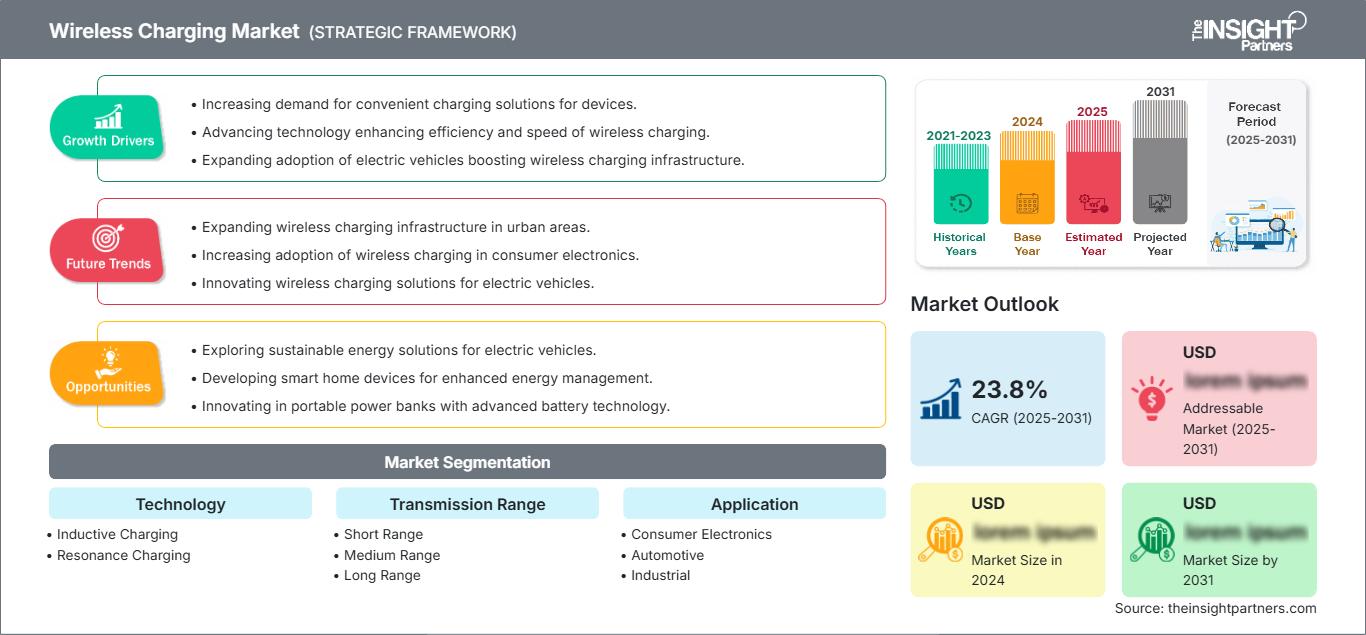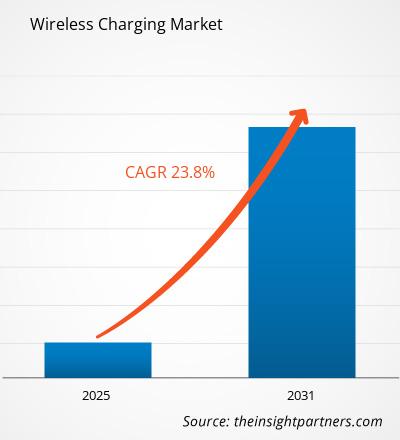Der Markt für kabelloses Laden wird voraussichtlich zwischen 2025 und 2031 eine durchschnittliche jährliche Wachstumsrate (CAGR) von 23,8 % verzeichnen, wobei die Marktgröße von XX Millionen US-Dollar im Jahr 2024 auf XX Millionen US-Dollar im Jahr 2031 anwachsen wird.
Der Bericht ist nach Technologie (induktives Laden und Resonanzladen), Übertragungsreichweite (kurze Reichweite, mittlere Reichweite und große Reichweite), Anwendung [Unterhaltungselektronik (Smartphones, PCs und Tablets, Wearables und andere), Automobil, Industrie, Regierung und Verteidigung, andere] segmentiert. Die globale Analyse ist weiter nach regionalen und wichtigen Ländern aufgeschlüsselt. Der Bericht bietet den Wert in USD für die oben genannte Analyse und Segmente.
Zweck des Berichts
Der Bericht „Markt für kabelloses Laden“ von The Insight Partners zielt darauf ab, die aktuelle Situation und das zukünftige Wachstum sowie die wichtigsten treibenden Faktoren, Herausforderungen und Chancen zu beschreiben. Dadurch erhalten verschiedene Geschäftsinteressenten Einblicke, beispielsweise:
- Technologieanbieter/-hersteller: Um die sich entwickelnde Marktdynamik zu verstehen und die potenziellen Wachstumschancen zu kennen, sodass sie fundierte strategische Entscheidungen treffen können.
- Investoren: Um eine umfassende Trendanalyse hinsichtlich der Marktwachstumsrate, der finanziellen Marktprognosen und der Chancen entlang der Wertschöpfungskette durchzuführen.
- Regulierungsbehörden: Um Richtlinien und Überwachungsaktivitäten auf dem Markt zu regulieren, mit dem Ziel, Missbrauch zu minimieren, das Vertrauen der Investoren zu wahren und die Integrität und Stabilität des Marktes aufrechtzuerhalten.
Marktsegmentierung für kabelloses Laden – Technologie
- Induktives Laden
- Resonanzladen
Übertragungsreichweite
- Kurze Reichweite
- Mittlere Reichweite
- Lange Reichweite
Anwendung
- Unterhaltungselektronik
- Automobilindustrie
- Industrie
- Regierung und Verteidigung
Geografie
- Nordamerika
- Europa
- Asien-Pazifik
- Süd- und Mittelamerika
- Naher Osten und Afrika
Sie erhalten kostenlos Anpassungen an jedem Bericht, einschließlich Teilen dieses Berichts oder einer Analyse auf Länderebene, eines Excel-Datenpakets sowie tolle Angebote und Rabatte für Start-ups und Universitäten.
Markt für kabelloses Laden: Strategische Einblicke

-
Holen Sie sich die wichtigsten Markttrends aus diesem Bericht.Dieses KOSTENLOSE Beispiel umfasst Datenanalysen, die von Markttrends bis hin zu Schätzungen und Prognosen reichen.
Wachstumstreiber für den Markt für kabelloses Laden
- Zunehmende Verbreitung von Mobilgeräten und Unterhaltungselektronik: Einer der Haupttreiber des Marktes für kabelloses Laden ist die weite Verbreitung von Smartphones und anderer Unterhaltungselektronik mit kabelloser Ladefunktion. Viele Top-Smartphones, darunter die von Apple, Samsung und Google, nutzen die Qi-basierte kabellose Ladetechnologie und machen sie damit zu einer Standardfunktion moderner Geräte. Da Verbraucher zunehmend Komfort von ihrer Technologie erwarten, steigt die Nachfrage nach kabellosem Laden, da es eine kabellose und einfache Möglichkeit zum Laden von Geräten bietet.
- Wachstum von Elektrofahrzeugen (EVs): Der Markt für Elektrofahrzeuge ist ein weiterer wichtiger Treiber für die Branche des kabellosen Ladens. Da Elektrofahrzeuge aufgrund wachsender Umweltbedenken und staatlicher Anreize immer beliebter werden, erforschen Autohersteller und Technologieunternehmen kabellose Ladelösungen als bequemere Möglichkeit zum Laden von Elektrofahrzeugen. Kabelloses Laden von Elektrofahrzeugen bietet die Möglichkeit eines problemlosen, automatischen Ladens ohne Kabel. Innovationen wie dynamisches Laden (das das Laden von Fahrzeugen während der Fahrt über induktive Ladepads ermöglicht) und statisches Laden (Laden bei geparktem Fahrzeug) treiben den Markt für kabelloses Laden voran.
Zukünftige Trends im Markt für kabelloses Laden
- Over-the-Air-Laden: Over-the-Air-Laden (OTAC) ist die Zukunft des kabellosen Ladens, da es so bequem ist und den physischen Kontakt zwischen Ladegerät und Gerät überflüssig macht. Im Gegensatz zu typischen kabellosen Ladetechnologien, bei denen Gegenstände auf eine bestimmte Oberfläche gelegt werden müssen, stellt OTAC eine Welt vor, in der Ihr Smartphone, Ihre Smartwatch oder andere Geräte einfach durch die Nähe zu einer Ladequelle aufgeladen werden können. Darüber hinaus wurde die kabellose Over-the-Air-Ladetechnologie in einer Vielzahl von Produkten implementiert, darunter intelligente Türschlösser und kontaktlose Ladestationen.
- Nachfrage nach kabellosem Laden in Automobilen: Der Automobilsektor erlebt einen deutlichen Trend zur Integration kabelloser Ladelösungen in Elektrofahrzeuge. Dieser Trend beschränkt sich nicht nur auf Personenkraftwagen, sondern dehnt sich auch auf Elektrobusse und -lastwagen aus. Da Verbraucher und Unternehmen nach effizienteren Möglichkeiten zum Laden von Elektrofahrzeugen suchen, gewinnen sowohl das statische kabellose Laden (Laden bei geparktem Fahrzeug) als auch das dynamische kabellose Laden (Laden während der Fahrt) an Bedeutung. Dieser Trend wird durch Fortschritte beim induktiven Laden und die regulatorische Unterstützung umweltfreundlicher Technologien vorangetrieben, sodass kabelloses Laden auch in Zukunft eine praktikable Lösung für Elektrofahrzeuge darstellt.
Marktchancen für kabelloses Laden
- Fortschritte in der Ladetechnologie: Die kabellose Ladetechnologie wird durch kontinuierliche Verbesserungen effizienter, schneller und kostengünstiger. Entwicklungen bei induktiven und resonanten Ladetechnologien, wie z. B. eine effizientere Energieübertragung, machen kabelloses Laden gegenüber kabelgebundenem Laden wettbewerbsfähiger. Unternehmen arbeiten außerdem daran, die Ladereichweite zu erhöhen, um Ladepads bequemer zu machen und eine präzise Ausrichtung überflüssig zu machen. Mit fortschreitender Weiterentwicklung der Technologie wird kabelloses Laden voraussichtlich immer weiter verbreitet sein und somit in einem breiteren Anwendungsspektrum Anwendung finden.
- Zunehmende Anwendung in zahlreichen Branchen: Drahtlose Ladetechnologien haben ihre Präsenz in zahlreichen Branchen ausgebaut, darunter im Gesundheitswesen, im Smart Home und anderen. Drahtlose Technologie ist in medizinischen Geräten, bei denen Sicherheit und Hygiene an erster Stelle stehen, unverzichtbar. Sie versorgt Implantate und Wearables ohne störende Anschlüsse mit Strom. Ebenso wird drahtlose Ladetechnologie zur Stromversorgung von Geräten, Robotern und fahrerlosen Transportfahrzeugen (FTF) eingesetzt. Diese Technik steigert die Produktivität, da manuelles Laden überflüssig wird.
Regionale Einblicke in den Markt für kabelloses Laden
Die Analysten von The Insight Partners haben die regionalen Trends und Faktoren, die den Markt für kabelloses Laden im Prognosezeitraum beeinflussen, ausführlich erläutert. In diesem Abschnitt werden auch die Marktsegmente und die geografische Lage in Nordamerika, Europa, dem asiatisch-pazifischen Raum, dem Nahen Osten und Afrika sowie Süd- und Mittelamerika erörtert.
Umfang des Marktberichts zum kabellosen Laden
| Berichtsattribut | Einzelheiten |
|---|---|
| Marktgröße in 2024 | US$ XX million |
| Marktgröße nach 2031 | US$ XX Million |
| Globale CAGR (2025 - 2031) | 23.8% |
| Historische Daten | 2021-2023 |
| Prognosezeitraum | 2025-2031 |
| Abgedeckte Segmente |
By Technologie
|
| Abgedeckte Regionen und Länder |
Nordamerika
|
| Marktführer und wichtige Unternehmensprofile |
|
Dichte der Marktteilnehmer für kabelloses Laden: Auswirkungen auf die Geschäftsdynamik verstehen
Der Markt für kabelloses Laden wächst rasant. Die steigende Nachfrage der Endnutzer ist auf Faktoren wie veränderte Verbraucherpräferenzen, technologische Fortschritte und ein stärkeres Bewusstsein für die Produktvorteile zurückzuführen. Mit der steigenden Nachfrage erweitern Unternehmen ihr Angebot, entwickeln Innovationen, um den Bedürfnissen der Verbraucher gerecht zu werden, und nutzen neue Trends, was das Marktwachstum weiter ankurbelt.

- Holen Sie sich die Markt für kabelloses Laden Übersicht der wichtigsten Akteure
Wichtige Verkaufsargumente
- Umfassende Abdeckung: Der Bericht analysiert umfassend Produkte, Dienstleistungen, Typen und Endnutzer des Marktes für kabelloses Laden und bietet einen ganzheitlichen Überblick.
- Expertenanalyse: Der Bericht basiert auf den umfassenden Erkenntnissen von Branchenexperten und Analysten.
- Aktuelle Informationen: Der Bericht gewährleistet Geschäftsrelevanz durch die Berichterstattung über aktuelle Informationen und Datentrends.
- Anpassungsoptionen: Dieser Bericht kann an spezifische Kundenanforderungen angepasst werden und passt sich so optimal an die Geschäftsstrategien an.
Der Forschungsbericht zum Markt für kabelloses Laden kann daher dabei helfen, die Branchensituation und die Wachstumsaussichten zu entschlüsseln und zu verstehen. Obwohl es einige berechtigte Bedenken geben mag, überwiegen die Vorteile dieses Berichts tendenziell die Nachteile.
- Historische Analyse (2 Jahre), Basisjahr, Prognose (7 Jahre) mit CAGR
- PEST- und SWOT-Analyse
- Marktgröße Wert/Volumen – Global, Regional, Land
- Branchen- und Wettbewerbslandschaft
- Excel-Datensatz
Aktuelle Berichte
Verwandte Berichte
Erfahrungsberichte
Grund zum Kauf
- Fundierte Entscheidungsfindung
- Marktdynamik verstehen
- Wettbewerbsanalyse
- Kundeneinblicke
- Marktprognosen
- Risikominimierung
- Strategische Planung
- Investitionsbegründung
- Identifizierung neuer Märkte
- Verbesserung von Marketingstrategien
- Steigerung der Betriebseffizienz
- Anpassung an regulatorische Trends






















 Kostenlose Probe anfordern für - Markt für kabelloses Laden
Kostenlose Probe anfordern für - Markt für kabelloses Laden